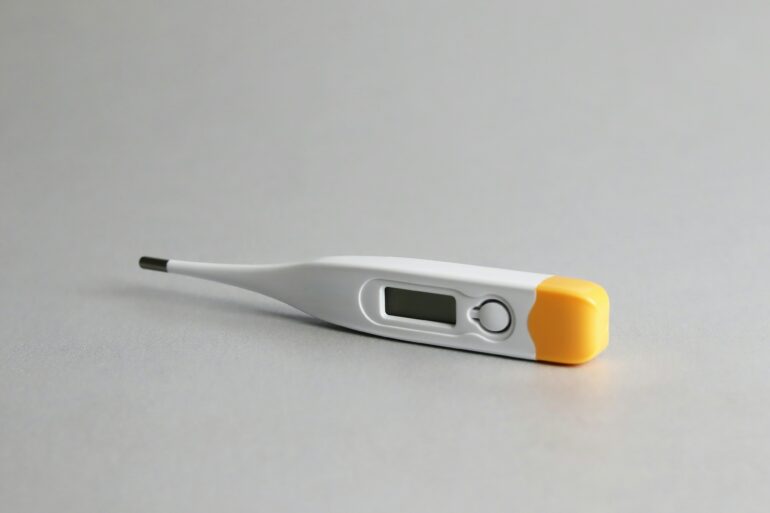Have you ever wished your immune system was stronger after getting sick with a fever? Your fever is a sign that your immune system is working! The immune system is the protective internal system within the human body. It is made up of a complex network of organs, specialized cells, and proteins that protect the body from outside invaders, including bacteria, viruses such as the flu and SARS-CoV-2, toxins, and even cancerous cells. Your immune system consists of two parts: the innate immune system and the adaptive immune system. While every individual is born with an innate immune system, their adaptive immune system develops as they grow, leading to some key differences between the two.
What is the human immune system?
The innate immune system produces nonspecific responses to any foreign pathogen the body detects, acting as the body’s first line of defense. For example, white blood cells rush to a laceration site to prevent infection or raise the body’s temperature (a fever!) to kill the infectious microbe detected. On the other hand, the adaptive immune system targets specific antigens—substances that induce an immune response in the body—and uses specialized cells, such as B cells and T cells, to attack that antigen. It builds a memory bank of antigens to facilitate the recognition of them as they enter the body or in the event of future exposure. Imagine if you got chicken pox as a child and experienced itchy blisters all over your body for a week. While that one week of recovery can be frustrating, the advantage is that you are now protected for life against chicken pox. This is because your body’s memory T cells and memory B cells develop an antigen-specific response to chicken pox that will attack the antigen before it affects you physically. Together, the two components work together to ensure the body’s safety and health are maintained.
In the modern world, science often focuses on the adaptive immune system for therapies against various diseases, but there are benefits to examining the innate immune system as well. As mentioned above, the innate immune system activates when it detects any foreign or “non-self” substance. A relevant application of focusing on the innate immune system involves cancer research, specifically the difference between cold and hot tumors. Hot tumors are tumors that already show signs of inflammation at the time of diagnosis, meaning T cells have already infiltrated the area and are rushing to fight cancerous cells. In contrast, cold tumors have not been infiltrated with immune cells, lacking any form of an immune response to them. Think of it this way: hot tumors have immune cells around them while cold tumors do not, leading many scientists to study hot tumors because the immune system is already at work there. However, only a few cancers are considered hot tumors. Thus, to improve the field of immunotherapy, it is crucial to understand the various biochemical mechanisms in our innate immune system that assist in an immune response to cold tumors.
The STING Signaling Pathway and Its Applications:
There are hundreds of biochemical mechanisms in our body that ensure our immune system functions, including the STING signaling pathway. This pathway mediates innate immune responses during infection and other cellular stresses, such as cancer. It begins when the protein cGAS (cyclic GMP-AMP synthase) detects double-stranded DNA in the cytosol, the liquid making up the cytoplasm of the cell. DNA is usually contained within the nucleus, so when cGAS identifies DNA in the cytosol, it recognizes the unusual location and works to make this threat disappear. To do so, it binds to the DNA. Upon binding, cGAS synthesizes cyclic GMP-AMP (cGAMP), which is a second messenger that binds to and activates the stimulator of interferon genes (STING). Activated STING recruits TANK Binding Kinase 1 (TBK1), which adds a phosphate group (phosphorylates) to STING, as well as Interferon Regulatory Factor 3 (IRF3). TBK1 then phosphorylates IRF3 molecules and translocates them to the nucleus. At the nucleus, phosphorylated IRF3 induces the transcription of type I interferons and proinflammatory cytokines, proteins that work to produce an immune response in the body. Type I interferons and proinflammatory cytokines are part of the body’s first line of defense, which means they are the very first components of the immune system that activate in the presence of a threat. Ultimately, the activation of the STING pathway by cytosolic DNA triggers an immune response to fight off pathogens.
While exploring mechanisms such as the STING pathway are viral to scientific understanding, how do scientists use this knowledge of the immune system to fight against diseases like cancer? Immunotherapies are types of cancer therapies that use immune system components made naturally by the human body or synthetically in a laboratory to destroy cancer cells. Immunotherapies can be sole treatments for specific types of cancers, or used in combination with other cancer treatments, like chemotherapy and radiation. While there are many forms of targeted immunotherapies, such as monoclonal antibodies and immune checkpoint inhibitors, non-specific immunotherapies employ the immune system as a whole to destroy cancer cells. For example, cytokines are used in non-specific immunotherapy cancer treatments to induce an immune response. These cytokines are classified into two categories: interferons (mentioned above in the STING pathway) and interleukins, a type of cytokines released primarily by white blood cells. For example, treatments in breast cancer utilize STING agonists and chronic myeloid leukemia therapies commonly target interferon-alpha. Because of the focus on interferons in cancer treatments, understanding pathways like the STING signaling pathway can yield remarkable results that help us transform the world of cancer therapy.
What measures can we take to protect our immune system?
For those not experiencing illness and looking for preventative measures, how can we improve our immune system health? The immune system does a remarkable job of defending the human body against harmful pathogens, but it fails at times. Although the correlation between lifestyle and enhanced immune function is still murky, there are ways to change lifestyle that likely improve immune function. According to Harvard Health, it is recommended that individuals should not smoke, drink alcohol only in moderation, and minimize stress. Additionally, eating a balanced diet, exercising regularly, and getting adequate sleep are known to have positive effects on human health. Research also shows that increasing the count of micronutrients in the body, such as magnesium and zinc, can prevent immunodeficiencies that lead to various immune system problems. In regard to cancer, avoiding tobacco, protecting yourself from the sun, and maintaining a healthy lifestyle and weight are known to decrease an individual’s risk of cancer. As the field of cancer treatment expands, it is pivotal that we take appropriate measures to ensure that our immune system functions properly to do its extraordinary job.
References:
- https://www.hopkinsmedicine.org/health/conditions-and-diseases/the-immune-system
- https://www.criver.com/eureka/immunology-non-immunologists-innate-vs-adaptive-immunity#:~:text=While%20innate%20immunity%20mounts%20a,immunity%20responds%20to%20specific%20antigens.
- https://www.betterhealth.vic.gov.au/health/conditionsandtreatments/immune-system
- https://www.khanacademy.org/test-prep/mcat/organ-systems/the-immune-system/a/innate-immunity
- https://www.criver.com/eureka/hot-tumors-vs-cold-tumors
- https://www.ncbi.nlm.nih.gov/pmc/articles/PMC9250635/
- https://www.cancer.net/navigating-cancer-care/how-cancer-treated/immunotherapy-and-vaccines/what-immunotherapy
- https://www.health.harvard.edu/staying-healthy/how-to-boost-your-immune-system
- https://www.mayoclinic.org/healthy-lifestyle/adult-health/in-depth/cancer-prevention/art-20044816
- https://www.cancer.org/cancer/types/chronic-myeloid-leukemia/treating/interferon-therapy.html#:~:text=Interferon%2Dalpha%20is%20a%20man,chronic%20myeloid%20leukemia%20(CML).
- https://unsplash.com/photos/white-and-yellow-thermometer-on-white-surface-iaHZUC69YHA

